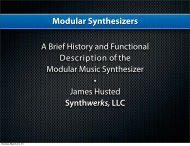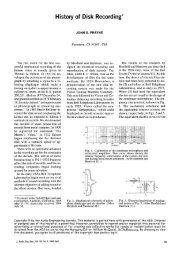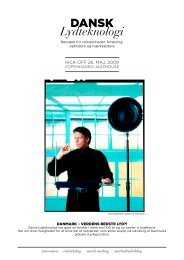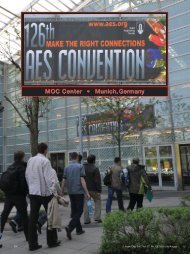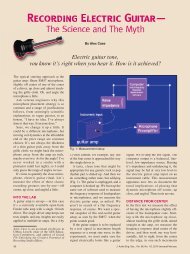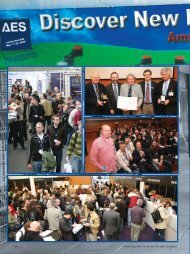Effect of Sound Intensity Level on Judgement of - Audio Engineering ...
Effect of Sound Intensity Level on Judgement of - Audio Engineering ...
Effect of Sound Intensity Level on Judgement of - Audio Engineering ...
You also want an ePaper? Increase the reach of your titles
YUMPU automatically turns print PDFs into web optimized ePapers that Google loves.
The <str<strong>on</strong>g>Effect</str<strong>on</strong>g> <str<strong>on</strong>g>of</str<strong>on</strong>g> <str<strong>on</strong>g>Sound</str<strong>on</strong>g> <str<strong>on</strong>g>Intensity</str<strong>on</strong>g><br />
<str<strong>on</strong>g>Level</str<strong>on</strong>g> <strong>on</strong> Judgment <str<strong>on</strong>g>of</str<strong>on</strong>g> "T<strong>on</strong>al<br />
Range" and "Volume <str<strong>on</strong>g>Level</str<strong>on</strong>g>"<br />
F<br />
OR MANY YEARS we have been aware<br />
that changes in the physical intensity<br />
<str<strong>on</strong>g>of</str<strong>on</strong>g> sounds are accompanied by<br />
changes in the subjective dimensi<strong>on</strong><br />
which we call loudfiess. We also know<br />
that for the normal human listener<br />
these two quantities are not always<br />
linearly related. This becomes apparent<br />
when we stimulate the ear with pure<br />
t<strong>on</strong>es at variom frequencies, over a<br />
range <str<strong>on</strong>g>of</str<strong>on</strong>g> intensity-level. Figure 1 will<br />
illustrate this point. Here the data <str<strong>on</strong>g>of</str<strong>on</strong>g><br />
Fletcher and Muns<strong>on</strong>l are displayed in<br />
a form enabling us to make direct comparis<strong>on</strong>s<br />
between the loudness <str<strong>on</strong>g>of</str<strong>on</strong>g> a given<br />
frequency at several intensity-levels, or<br />
between the loudness <str<strong>on</strong>g>of</str<strong>on</strong>g> several fre-<br />
*Research Psychologist U.S.N. Medical<br />
Research Laboratory U.S.N. Submarine<br />
Base, New L<strong>on</strong>d<strong>on</strong>, Corn.<br />
'H. Fletcher and W. A. Muns<strong>on</strong>. Loud-<br />
ness, its definiti<strong>on</strong>, measurement and cal-<br />
culati<strong>on</strong>. J. Acous. Soc. Am. 5, 2, 82, 1933.<br />
Opini<strong>on</strong>s and c<strong>on</strong>clusi<strong>on</strong>s expressed in this<br />
paper are the author's own and do not<br />
reflect policies <str<strong>on</strong>g>of</str<strong>on</strong>g> the United States Navy.<br />
paper rests up<strong>on</strong> the author, and statements<br />
c<strong>on</strong>tained herein are not binding<br />
ua<strong>on</strong> the <strong>Audio</strong> En~ineerin~ Societv.<br />
Fi? 1,. The loudness functi<strong>on</strong>, showing how<br />
sound intensity-level (reference lo-*' watt/<br />
cmP) affects the loudness <str<strong>on</strong>g>of</str<strong>on</strong>g> pyre. t<strong>on</strong>es at dif-<br />
ferent frequencies in the useful auditory spec-<br />
trum. Frequency is shown as parameter.<br />
STEPHEN E. STUNTZ"<br />
A discussi<strong>on</strong> <str<strong>on</strong>g>of</str<strong>on</strong>g> the wide variety <str<strong>on</strong>g>of</str<strong>on</strong>g> factors which influence<br />
the c<strong>on</strong>clusi<strong>on</strong>s derived from listener preference tests.<br />
quencies at a_ single intensity-level. The<br />
scaling <str<strong>on</strong>g>of</str<strong>on</strong>g> the psychological dimensi<strong>on</strong>,<br />
loudness, in this figure follows the rec-<br />
ommendati<strong>on</strong>s <str<strong>on</strong>g>of</str<strong>on</strong>g> the American Stand-<br />
ards Associati<strong>on</strong> Committee <strong>on</strong> Acous-<br />
tical Measurements and Terminology2;<br />
the term "s<strong>on</strong>e" is applied to the unit <str<strong>on</strong>g>of</str<strong>on</strong>g><br />
loudness measurement accordittg to a<br />
suggesti<strong>on</strong> by st even^.^ Intensrty-level<br />
is referred 10 theacoustical standard <str<strong>on</strong>g>of</str<strong>on</strong>g><br />
10-I= watt per cm2.<br />
The curves shown here depict the<br />
growth <str<strong>on</strong>g>of</str<strong>on</strong>g> sensati<strong>on</strong> magnitude with sig-<br />
nal intensity, at a variety <str<strong>on</strong>g>of</str<strong>on</strong>g> frequencies.<br />
FREQUENCY - CYCLES PER SECOND<br />
Fig. 2. An interpretati<strong>on</strong> <str<strong>on</strong>g>of</str<strong>on</strong>g> the loudness func-<br />
ti<strong>on</strong>, showing how the over-all frequency-re-<br />
sp<strong>on</strong>se <str<strong>on</strong>g>of</str<strong>on</strong>g> normal human hearing varies with<br />
the intensity-level <str<strong>on</strong>g>of</str<strong>on</strong>g> sound. <str<strong>on</strong>g>Intensity</str<strong>on</strong>g>-level is<br />
the parameter.<br />
They characterize the reacti<strong>on</strong>s <str<strong>on</strong>g>of</str<strong>on</strong>g> an<br />
average listener over the greater porti<strong>on</strong><br />
<str<strong>on</strong>g>of</str<strong>on</strong>g> the useful auditory spectruni. Several<br />
details are worth special attenti<strong>on</strong>: first,<br />
that although the growth <str<strong>on</strong>g>of</str<strong>on</strong>g> loudness is<br />
far more rapid at low (those below 200<br />
cps) than at high frequencies for ordi-<br />
nary intensity-levels, much greater in-<br />
tensity <str<strong>on</strong>g>of</str<strong>on</strong>g> sound is required at the low<br />
frequencies to initiate any sensati<strong>on</strong> at<br />
all. Sec<strong>on</strong>d, the rate <str<strong>on</strong>g>of</str<strong>on</strong>g> growth is not<br />
uniform for all frequencies until an in-<br />
tensity-level is reached approaching the<br />
a Proposed standards for noise measure<br />
hent. J. Acous. Soc, Am. 5, 2, 109, 1933.<br />
S. S. Stevens. A scale for. the measure-<br />
ment <str<strong>on</strong>g>of</str<strong>on</strong>g> a psychological magnitude: loud-<br />
ness. Psychol. Rev. 43, 405, 1936.<br />
n +5<br />
u<br />
I-<br />
3 -to<br />
z<br />
-<br />
I-<br />
l-<br />
a -eo<br />
W<br />
2-25-<br />
I- I<br />
3 -30 -<br />
W<br />
a -35 -<br />
N MINAL RANOES .<br />
A . "wI:Es (40-toooocps) !<br />
B . .MEDIUM" (60-6000 OPS) 1<br />
C . 'NARROW. (150-4900 CPS) ,<br />
e 6<br />
100<br />
6 4 1<br />
4000<br />
6 1 0<br />
low0<br />
FREQUENCY-CYCLES PER SECOND<br />
Fig. 3. Resp<strong>on</strong>se characteristics <str<strong>on</strong>g>of</str<strong>on</strong>g> Eisenberg<br />
and Chinn's electrical system, exclusive <str<strong>on</strong>g>of</str<strong>on</strong>g><br />
loudspeaker, used in their study <str<strong>on</strong>g>of</str<strong>on</strong>g> preference<br />
for "t<strong>on</strong>al range" and "volume level." (Repro-<br />
duced from the Journal <str<strong>on</strong>g>of</str<strong>on</strong>g> Experimental Psy-<br />
chology, 1945, by permissi<strong>on</strong> <str<strong>on</strong>g>of</str<strong>on</strong>g> that Journal and<br />
<str<strong>on</strong>g>of</str<strong>on</strong>g> the American Psychological Associati<strong>on</strong>.)<br />
threshold <str<strong>on</strong>g>of</str<strong>on</strong>g> feeling, that is, n<strong>on</strong>-audi-<br />
tory sensati<strong>on</strong>. Third, the loudness <str<strong>on</strong>g>of</str<strong>on</strong>g><br />
frequencies in the range 700 to 4000 cps<br />
seems to be affected by intensity<br />
changes least <str<strong>on</strong>g>of</str<strong>on</strong>g> all. It will be recalled<br />
that the normal human ear is most sensi-<br />
tive to this porti<strong>on</strong> <str<strong>on</strong>g>of</str<strong>on</strong>g> the spectrum,<br />
<str<strong>on</strong>g>of</str<strong>on</strong>g>ten called the "middle range." Fourth<br />
and last, loudness shifts at the higher<br />
frequencies (around 10,000 cps) , those<br />
with which we are <str<strong>on</strong>g>of</str<strong>on</strong>g>ten c<strong>on</strong>cerned in<br />
"high-fidelity" sound reproducti<strong>on</strong>, are<br />
not greatly different from those <str<strong>on</strong>g>of</str<strong>on</strong>g> the<br />
middle frequencies. In summati<strong>on</strong>, these<br />
curves suggest that the ear's frequency<br />
resp<strong>on</strong>se is to a c<strong>on</strong>siderable extent di-<br />
rectly influenced by the intensity <str<strong>on</strong>g>of</str<strong>on</strong>g><br />
stimulating sounds.<br />
Let us review this c<strong>on</strong>clusi<strong>on</strong> in more<br />
c<strong>on</strong>venti<strong>on</strong>al terms. Figure 2, based <strong>on</strong><br />
the same data as Fig. 1, shows directly<br />
how variati<strong>on</strong>s <str<strong>on</strong>g>of</str<strong>on</strong>g> intensity affect what<br />
might be called the normal listener's<br />
frequency resp<strong>on</strong>se. The four intensity<br />
levels shown as parameters-50, 60, 70,<br />
and 75 db--were chosen <strong>on</strong> the basis <str<strong>on</strong>g>of</str<strong>on</strong>g><br />
some experimental data which will be<br />
discussed subsequently. The implicati<strong>on</strong>s<br />
<str<strong>on</strong>g>of</str<strong>on</strong>g> this figure are <str<strong>on</strong>g>of</str<strong>on</strong>g> c<strong>on</strong>siderable in-<br />
terest to the audio engineer. For <strong>on</strong>e<br />
thing, the ear does not behave like the<br />
usual electroacoustic transducer, whose<br />
AUDIO ENGINEERING JUNE, 1951 \ 17
frequency resp<strong>on</strong>se remains relativily<br />
unchanged over a range <str<strong>on</strong>g>of</str<strong>on</strong>g> intensities<br />
limited at the upper extreme by the <strong>on</strong>-<br />
set <str<strong>on</strong>g>of</str<strong>on</strong>g> overloading. In this c<strong>on</strong>necti<strong>on</strong>, it<br />
is noteworthy that the 75-db intensity<br />
level is far below the ear's overload<br />
limit. Therefore, we cannot say that the<br />
apparent broadening <str<strong>on</strong>g>of</str<strong>on</strong>g> the flat top <str<strong>on</strong>g>of</str<strong>on</strong>g><br />
the curve is necessarily related to over-<br />
excitati<strong>on</strong> <str<strong>on</strong>g>of</str<strong>on</strong>g> the auditory mechanism.<br />
Another point <str<strong>on</strong>g>of</str<strong>on</strong>g> importance is that<br />
when we raise signal intensity from 50<br />
db to 75 db, we effectively add to the<br />
listener's range at 1 s<strong>on</strong>e, or 1000 milli-<br />
s<strong>on</strong>es, loudness, something over three<br />
octaves downward frpm 400 cps. Put<br />
another way,'by raising the intensity-<br />
level from 50 db to 75 db, we render a<br />
125-cps t<strong>on</strong>e over 90 times louder for<br />
the average listener. By either stater<br />
ment, it is evident that a tremendous im-<br />
provement <str<strong>on</strong>g>of</str<strong>on</strong>g> the ear's effective bass<br />
resp<strong>on</strong>se follows a rise in over-all signal<br />
intensity. To a somewhat lesser extent,<br />
the same is true at the treble end <str<strong>on</strong>g>of</str<strong>on</strong>g> the<br />
spectrum, as these curves suggest. It is<br />
expected that the 50-db c<strong>on</strong>tour, if ex-<br />
tended, would intersect the 100 millis<strong>on</strong>e<br />
(0.1 s<strong>on</strong>e) loudness ordinate just below<br />
20,000 cps, or near the upper frequency<br />
limit <str<strong>on</strong>g>of</str<strong>on</strong>g> normal hearing.<br />
Listener Preferences<br />
Recently a number <str<strong>on</strong>g>of</str<strong>on</strong>g> experimenters<br />
have investigated the preference <str<strong>on</strong>g>of</str<strong>on</strong>g> lis-<br />
teners for various c<strong>on</strong>diti<strong>on</strong>s <str<strong>on</strong>g>of</str<strong>on</strong>g> fre-<br />
quency range and intensity-level in the<br />
reproducti<strong>on</strong> <str<strong>on</strong>g>of</str<strong>on</strong>g> music and speech. Of<br />
the several studies reported, the most ex-<br />
tensively documented appear to be<br />
Eisenberg and Chinn's4 and Ols<strong>on</strong>>.s<br />
In both <str<strong>on</strong>g>of</str<strong>on</strong>g> these experiments, it will be<br />
recalled, listeners were required to com-<br />
pare c<strong>on</strong>secutive passages <str<strong>on</strong>g>of</str<strong>on</strong>g> musical se-<br />
lecti<strong>on</strong>s played through adjustable fre-<br />
quency filters. In Eisenberg and Chinn's<br />
study, electrical filters were employed<br />
restricting the ,range at both ends simul-<br />
taneously. Figzcre 3 shows the three<br />
band-pass characteristics up<strong>on</strong> which<br />
their listeners based judgments <str<strong>on</strong>g>of</str<strong>on</strong>g> "t<strong>on</strong>al<br />
range" preference. The authors note<br />
that these curves apply <strong>on</strong>ly to the elec-<br />
trical porti<strong>on</strong>s <str<strong>on</strong>g>of</str<strong>on</strong>g> their apparatus; in dis-<br />
cussing their results, they imply ,that<br />
these curves also represent c<strong>on</strong>diti<strong>on</strong>s in<br />
the acoustical field surrounding their<br />
listeners. It will also be recalled that<br />
Eisenberg and Chinn studied preference<br />
for program intensity-level, choosing 50,<br />
60, and 70 db as the three values for<br />
comparis<strong>on</strong>. In <strong>on</strong>e series <str<strong>on</strong>g>of</str<strong>on</strong>g> subexperi-<br />
'P. Eisenberg and H. A. Chinn.' T<strong>on</strong>al<br />
range and volume level preferences <str<strong>on</strong>g>of</str<strong>on</strong>g> broad-<br />
cast listeners. J. Ex@. Psychol. 35, 5, 374,<br />
October 1945.<br />
6H. F. Ols<strong>on</strong>. Frequency range pref-<br />
erences for speech and music. J. Acow. Soc.<br />
AM. 19,4, 549, July 1947.<br />
ments, these three intensi6-levels were<br />
combined with the three frequency passbands<br />
already described, and the listeners<br />
asked to state preference for the resultant<br />
c<strong>on</strong>diti<strong>on</strong> <str<strong>on</strong>g>of</str<strong>on</strong>g> both "t<strong>on</strong>al range"<br />
and ''volu~e level."' As we have already<br />
seen, when a sufficient change in signal<br />
intensity occurs listeners will report an<br />
apparent change in frequency range<br />
even though no physical c<strong>on</strong>trol <str<strong>on</strong>g>of</str<strong>on</strong>g> passband<br />
has 'been imposed. Now in the<br />
measurement <str<strong>on</strong>g>of</str<strong>on</strong>g> preferences, 'it is important<br />
that the c<strong>on</strong>diti<strong>on</strong>s serving as<br />
bases for judgment be clearly discrim-<br />
-<br />
100 1000<br />
FREQUENCY-'CYCLES PER SECOND<br />
inable to the average observer. If the Fig. 4. Subiective effect <str<strong>on</strong>g>of</str<strong>on</strong>g> Eisenberg and<br />
differences between them be discernible Ckinn's "medium t<strong>on</strong>al range" filters at "high"<br />
(70-db), "moderate" (60-db), and "low" (50<strong>on</strong>ly<br />
by chance, then the observer is db) volume levels. Broken lines indicate cut<str<strong>on</strong>g>of</str<strong>on</strong>g>f<br />
plainly handicapped in stating his pref- effect <str<strong>on</strong>g>of</str<strong>on</strong>g> filters. Note the apparent ineffectiveness<br />
<str<strong>on</strong>g>of</str<strong>on</strong>g> high-pass filters at 50 and<br />
erence with certainty. ~~~~i~~ this in<br />
60 db.<br />
mind, then, let us look at the effects <str<strong>on</strong>g>of</str<strong>on</strong>g><br />
Eisenberg and Chinn's filters up<strong>on</strong> the<br />
auditory spectrum as perceived by an<br />
average observer under the three in-<br />
tensity-levels used. Returning to Fig. 2,<br />
we can estimate from the 50, 60, and 70<br />
db curves the perceptual results <str<strong>on</strong>g>of</str<strong>on</strong>g> sound<br />
transmissi<strong>on</strong> through a system nominally<br />
flat from 40 to 10,000 cps, corresp<strong>on</strong>ding<br />
totthe "wide t<strong>on</strong>al range" <str<strong>on</strong>g>of</str<strong>on</strong>g> these ex-<br />
periments. Figure 4.shows the subjective<br />
effect <str<strong>on</strong>g>of</str<strong>on</strong>g> the "medium-t<strong>on</strong>al-range," that<br />
in<br />
W<br />
z<br />
in 0<br />
10 -<br />
I<br />
% 1-<br />
W z<br />
0 3<br />
3<br />
70 db<br />
100 XMO moo0<br />
FREQUENCY - CYCLES PER SECOND<br />
is, 60 to 6,000 cps, filtering: it will be<br />
noted that a the 'igh Fig. 5. f ubjectivc effect <str<strong>on</strong>g>of</str<strong>on</strong>g> Iisenberg and<br />
level" do the restricti<strong>on</strong>s at both high Chinn's "narrow t<strong>on</strong>al range" filters at ''hirrh"<br />
and low ends become noticeable. At (70-db), "moderate" (60-2b) and "low" (50db)<br />
volume levels. Broken lines indicate cut<str<strong>on</strong>g>of</str<strong>on</strong>g>f<br />
lower levels, the be effect <str<strong>on</strong>g>of</str<strong>on</strong>g> filters. Note relative ineffectiveness<br />
expected to report,mainly - a change in <str<strong>on</strong>g>of</str<strong>on</strong>g> high-pass filter at 50 db, and sliht effect<br />
/<br />
hi&s as a result <str<strong>on</strong>g>of</str<strong>on</strong>g> filteri&'but a iaria- <strong>on</strong> subjective bandwidth at' high eid caused<br />
by change in intensity-levels.<br />
ti<strong>on</strong> <str<strong>on</strong>g>of</str<strong>on</strong>g> both lows and highs would be<br />
reported as a result <str<strong>on</strong>g>of</str<strong>on</strong>g> the-changes in<br />
level. Figz~re.5, showing the effects <str<strong>on</strong>g>of</str<strong>on</strong>g><br />
"narrow-range," that is, 150 to 4,900<br />
cps, filtering, -suggests an opposite c<strong>on</strong>clusi<strong>on</strong><br />
: here the greatest perceived differences<br />
occur at the low-frequency end<br />
as level is varied. Restricti<strong>on</strong> at the high<br />
end is so severe that raising level from<br />
50 to 70 db expands subjective frequency<br />
range hardly more than half an<br />
100<br />
octave upward at 1 s<strong>on</strong>e loudness. Fig-<br />
FREQUENCY -CYCLES PER SECOND<br />
ures 2,4 and 5 indicate that a growth in<br />
the perceived range <str<strong>on</strong>g>of</str<strong>on</strong>g> frequencies prob- Fig. 6. Subjective effect <str<strong>on</strong>g>of</str<strong>on</strong>g> Eisenberg and<br />
Chinn's "wide," "medium" and "narrow t<strong>on</strong>al<br />
ably occurred independently <str<strong>on</strong>g>of</str<strong>on</strong>g> the band- range" filters at 704, intensity-level ("high<br />
pass imposed by means <str<strong>on</strong>g>of</str<strong>on</strong>g> fil- volume level"). Broken lines indicate cut<str<strong>on</strong>g>of</str<strong>on</strong>g>f<br />
ters.<br />
effect <str<strong>on</strong>g>of</str<strong>on</strong>g> filters.<br />
In Figs. 6, 7 a%d 8 we can see the "medium", that is, "A" with "B", diseffects<br />
<str<strong>on</strong>g>of</str<strong>on</strong>g> filtering at any <strong>on</strong>e <str<strong>on</strong>g>of</str<strong>on</strong>g> the criminativn is likely to be uncertain,<br />
three intensity-levels. Figure 6 suggests yieldin2 statements <str<strong>on</strong>g>of</str<strong>on</strong>g> preference not acthat<br />
at "high-volume level" the average ceptably reliable. Figzcre 7 shows an aglistener<br />
would experience little difficulty gravati<strong>on</strong> <str<strong>on</strong>g>of</str<strong>on</strong>g> this difficulty, brought about<br />
discerning the shift from "wide" to "nar- by reducing intensity-level to 60 db.<br />
row" ranges, that is, from band A to Here the three batids become more easily<br />
band C. Likewise, the shift from "me- c<strong>on</strong>fused, although discriminati<strong>on</strong> <str<strong>on</strong>g>of</str<strong>on</strong>g><br />
dium" to "narrow", band B to band C; :wide" (A) from "narrow" (C) might<br />
probably would be easily detected. HOW- still be accomplished with better than<br />
ever, in comparis<strong>on</strong>s <str<strong>on</strong>g>of</str<strong>on</strong>g> "wide" with chance success. Figure 8 presents a pic-<br />
AUDIO ENGINEERING * JUNE, 1951
ture <str<strong>on</strong>g>of</str<strong>on</strong>g> potential c<strong>on</strong>fusi<strong>on</strong> bordering <strong>on</strong><br />
chaos. Here, at 50 db intensity-level, dif-'<br />
ferential effects <str<strong>on</strong>g>of</str<strong>on</strong>g> high-pass filtering<br />
have almost disappeared. Any discrim- - $<br />
inati<strong>on</strong> am<strong>on</strong>g the three bands must be A<br />
made <strong>on</strong> the basis <str<strong>on</strong>g>of</str<strong>on</strong>g> changes at the high<br />
end al<strong>on</strong>e. Since there is relatively little g<br />
difference between "narrow" (C) and S<br />
"medium" (B) for the listener (perhaps<br />
<strong>on</strong>e-third <str<strong>on</strong>g>of</str<strong>on</strong>g> an octave above 5,000 cps<br />
too 1000<br />
at 1 s<strong>on</strong>e loudness), we would anticipate<br />
FREQUENCY -CYCLES PER SECOND<br />
4<br />
largely unreliable judgments <str<strong>on</strong>g>of</str<strong>on</strong>g> preference<br />
for <strong>on</strong>e or the other. However, the Fig. 7. Subjective effect <str<strong>on</strong>g>of</str<strong>on</strong>g> Eisenberg and<br />
Chinn's "wide," "mediun" and "narrow t<strong>on</strong>al<br />
subjective difference between '%ide,, range" filters at 60-db intensity-level ("mod-<br />
(A) and "narr~~" (C) is more evident, erate volume level"). Broken lines indicate<br />
and likely would prodbce more satisfac-<br />
cut<str<strong>on</strong>g>of</str<strong>on</strong>g>f effect <str<strong>on</strong>g>of</str<strong>on</strong>g> filters.<br />
tory indicati<strong>on</strong>s <str<strong>on</strong>g>of</str<strong>on</strong>g> preference.<br />
Eisenberg and Chinn's preferred combiq$ti<strong>on</strong>s<br />
<str<strong>on</strong>g>of</str<strong>on</strong>g> "t<strong>on</strong>al range" and "volume<br />
level" appear in the left-hand columns.<br />
From their results as here interpreted, .<br />
there emerge two facts <str<strong>on</strong>g>of</str<strong>on</strong>g> c<strong>on</strong>siderable<br />
importance. First, out <str<strong>on</strong>g>of</str<strong>on</strong>g> the twenty<br />
combinati<strong>on</strong>s <str<strong>on</strong>g>of</str<strong>on</strong>g> band-pass filtering, intensity-level,<br />
and musical c<strong>on</strong>tent which<br />
their listenefs were yked to evaluate,<br />
<strong>on</strong>ly the nine shown here appear to have<br />
produced adequately reliable statements<br />
<str<strong>on</strong>g>of</str<strong>on</strong>g> preference. This suggests that in the<br />
remaining eleven, judgment was complicated<br />
by inadequate discriminability<br />
<str<strong>on</strong>g>of</str<strong>on</strong>g> the c<strong>on</strong>diti<strong>on</strong>s <str<strong>on</strong>g>of</str<strong>on</strong>g>fered for comparis<strong>on</strong>,<br />
due either to the -effects <str<strong>on</strong>g>of</str<strong>on</strong>g> combining<br />
frequency-range and intensity-level, or<br />
In the experiments c<strong>on</strong>ducted by 01-<br />
to failure <str<strong>on</strong>g>of</str<strong>on</strong>g> the musical samples to sufs<strong>on</strong>,<br />
intensity-level was maintained at 75<br />
ficiently occupy the porti<strong>on</strong>s <str<strong>on</strong>g>of</str<strong>on</strong>g> sppctrum<br />
db throughout, and but two frequency-<br />
st~died.~ The sec<strong>on</strong>d important point is<br />
range c<strong>on</strong>diti<strong>on</strong>s were compared-unrestricted<br />
bandwidth, and a nominal 5,000<br />
cps low-pass. Figu~e 9 shows the physical<br />
effect <str<strong>on</strong>g>of</str<strong>on</strong>g> the frequency-range c<strong>on</strong>trols<br />
imposed in this experiment, while<br />
Fig. 10 represents the subjective effect<br />
<str<strong>on</strong>g>of</str<strong>on</strong>g> these c<strong>on</strong>trols. Observe that at the<br />
high frequency end this curve compares<br />
favorably with that for Eisenberg and<br />
Chinn's "narrow range" at 70 db (Fig.<br />
6, curve C), while the curve representing<br />
the effect <str<strong>on</strong>g>of</str<strong>on</strong>g> Ols<strong>on</strong>'s unrestricted<br />
c<strong>on</strong>diti<strong>on</strong> closely .resembles Eisenberg<br />
and Chinn's "wide-range" curve at<br />
"high volume level" (Fig. 2, 70 db).<br />
From these observati<strong>on</strong>s we might infer<br />
that as far as the high-frequency end <str<strong>on</strong>g>of</str<strong>on</strong>g><br />
the range is c<strong>on</strong>cerned, there was little<br />
difference between the discriminati<strong>on</strong><br />
task presented Ols<strong>on</strong>'s listeners and that<br />
c<strong>on</strong>fr<strong>on</strong>ting Eisenberg and Chinn's.<br />
Also, we may predict that Ols<strong>on</strong>'s two<br />
passbands should be easily discriminable<br />
<strong>on</strong> the. basis <str<strong>on</strong>g>of</str<strong>on</strong>g> their subjective differences,<br />
and therefore give rise to highly<br />
reliable estimates <str<strong>on</strong>g>of</str<strong>on</strong>g> preference for <strong>on</strong>e<br />
or the other.<br />
Analysis <str<strong>on</strong>g>of</str<strong>on</strong>g> Tests<br />
11 FREQUENCY - CYCLES PER SECOND I<br />
Fig. 8. Subjective effect <str<strong>on</strong>g>of</str<strong>on</strong>g> Eisenberg and<br />
Chinn's "wide," "medium" and "narrow t<strong>on</strong>al<br />
range" filters at 50-db intensity-level ("low<br />
volume l'evel"). Broken lines indicate cut<str<strong>on</strong>g>of</str<strong>on</strong>g>f<br />
effect <str<strong>on</strong>g>of</str<strong>on</strong>g> filters.<br />
FILTER<br />
OUT<br />
0<br />
-10 -<br />
-20 -<br />
-30 -<br />
-40 -<br />
5 4 i 6 i<br />
100 1000 1OOOO<br />
FREQUENCY -CYCLES PER SECOND I Fig. 9. Approximate resp<strong>on</strong>se characteristic <str<strong>on</strong>g>of</str<strong>on</strong>g><br />
acoustical filter system used in Ols<strong>on</strong>'s study<br />
<str<strong>on</strong>g>of</str<strong>on</strong>g> preference for frequelrcy range, showing<br />
acoustical cut<str<strong>on</strong>g>of</str<strong>on</strong>g>f <str<strong>on</strong>g>of</str<strong>on</strong>g> "5000-cps" low-pass<br />
filter.<br />
indicated by the asterisks appearing in<br />
the left-hand column <str<strong>on</strong>g>of</str<strong>on</strong>g> the upper table.<br />
Five out <str<strong>on</strong>g>of</str<strong>on</strong>g> nine <str<strong>on</strong>g>of</str<strong>on</strong>g> the reliably preferred<br />
combinati<strong>on</strong>s yield passbands which are<br />
subjectively broader than their n<strong>on</strong>-preferred<br />
counterparts, although by plzysical<br />
definiti<strong>on</strong> they are narrower. To<br />
some extent, the authors may have bekn<br />
aware <str<strong>on</strong>g>of</str<strong>on</strong>g> this apparent anomaly, for<br />
they c<strong>on</strong>clude that "the most reliable<br />
judgments were made when both toqal<br />
range and volume level were varied."T<br />
.However, the findings reported here<br />
str<strong>on</strong>gly suggest that their prime c<strong>on</strong>clusi<strong>on</strong>,<br />
"listeners prefer either a narrow<br />
or medium t<strong>on</strong>al range to a wide <strong>on</strong>e,"s<br />
may deserve careful reviewing. Submitting<br />
the results <str<strong>on</strong>g>of</str<strong>on</strong>g> Ols<strong>on</strong> to similar<br />
analysis, we do not find evidence <str<strong>on</strong>g>of</str<strong>on</strong>g> such<br />
c<strong>on</strong>taminating factors. (Table I) Evidently<br />
the passbands and intensity-level<br />
used so unequivocally structured the<br />
judgmental situati<strong>on</strong>, and were so occupied<br />
by the spectra <str<strong>on</strong>g>of</str<strong>on</strong>g> the musical<br />
samples chosen, that his listeners could<br />
make their choices relatively unhampered<br />
by doubt. All <str<strong>on</strong>g>of</str<strong>on</strong>g> the judgments<br />
rendered by his unselected listeners meet<br />
the criteri<strong>on</strong> for reliability, and definitely<br />
favor wide-passband transmissi<strong>on</strong><br />
over narrow.<br />
If the preceding arguments be ac-<br />
[C<strong>on</strong>tinued <strong>on</strong> page 26 1<br />
The published results <str<strong>on</strong>g>of</str<strong>on</strong>g> the two<br />
studies cited here have been analyzed<br />
for the purpose <str<strong>on</strong>g>of</str<strong>on</strong>g> estimating the relia-<br />
bility <str<strong>on</strong>g>of</str<strong>on</strong>g> preferences indicated by the.lis-<br />
teners. The results <str<strong>on</strong>g>of</str<strong>on</strong>g> this analysis are<br />
shown in Table I. Only the preferences<br />
<str<strong>on</strong>g>of</str<strong>on</strong>g> the "cross-secti<strong>on</strong>", or unspecialized,<br />
listeners are Geated, <strong>on</strong> the grounds that<br />
they are more representative <str<strong>on</strong>g>of</str<strong>on</strong>g> the gen-<br />
eral populati<strong>on</strong> than would be the judg-<br />
ments <str<strong>on</strong>g>of</str<strong>on</strong>g>, say, pr<str<strong>on</strong>g>of</str<strong>on</strong>g>essi<strong>on</strong>al musicians,<br />
high-fidelity enthusiasts, audio engi-<br />
neers, or other specialists. This * table<br />
summarizes <strong>on</strong>ly the testing in which<br />
music was used. It lists the preference-<br />
statements <str<strong>on</strong>g>of</str<strong>on</strong>g> whose occurrence we can<br />
be reas<strong>on</strong>ably sure 99 or more times out<br />
<str<strong>on</strong>g>of</str<strong>on</strong>g> 100 ('f.01 level <str<strong>on</strong>g>of</str<strong>on</strong>g> c<strong>on</strong>fidence").<br />
AUDIO ENGINEERING JUNE, 1951<br />
\<br />
\<br />
FILTER lN\<br />
1<br />
\ t<br />
\<br />
4 1 t<br />
too0 iwGQ<br />
I FREOUENCY -CYCLES PER SECOND 1<br />
Fig. 10. Subjective effect <str<strong>on</strong>g>of</str<strong>on</strong>g> Ols<strong>on</strong>'s "wide"<br />
and "narrow frequency range" filters at 75-db<br />
intensity-level. Broken line shows cut<str<strong>on</strong>g>of</str<strong>on</strong>g>f effect<br />
due to filter. Note similarity between this low-<br />
pass cut<str<strong>on</strong>g>of</str<strong>on</strong>g>f effect and that <str<strong>on</strong>g>of</str<strong>on</strong>g> Eisenberg and<br />
Chinn's "narrow t<strong>on</strong>al range" at "high volume<br />
level" (70-db curve, Fig. 5).<br />
In designing tests <str<strong>on</strong>g>of</str<strong>on</strong>g> this sort, <strong>on</strong>e must<br />
be aware that a mere statement <str<strong>on</strong>g>of</str<strong>on</strong>g> the range<br />
<str<strong>on</strong>g>of</str<strong>on</strong>g> frequencies which his apparatus will<br />
, transmit is insufficient evidence that this<br />
range was actually occupied by the sound<br />
<strong>on</strong> which the listeners had to base their<br />
preferences. Neither <str<strong>on</strong>g>of</str<strong>on</strong>g> the studies reviewed<br />
in this paper makes any direct menti<strong>on</strong> <str<strong>on</strong>g>of</str<strong>on</strong>g><br />
the frequency c<strong>on</strong>tent <str<strong>on</strong>g>of</str<strong>on</strong>g> the program material<br />
used. Some sort <str<strong>on</strong>g>of</str<strong>on</strong>g> sp,ectral analysis is<br />
plainly required in order to dem<strong>on</strong>strate<br />
the physical effect <str<strong>on</strong>g>of</str<strong>on</strong>g> the frequency-restricting<br />
c<strong>on</strong>trols imposed..<br />
' Zbid., p. 390.<br />
LOC. cit.<br />
19
SOUND INTENSITY LEVEL<br />
[from page 281<br />
TABLE I<br />
T<strong>on</strong>al Range/Volume <str<strong>on</strong>g>Level</str<strong>on</strong>g> Preferentes Significant at or Above<br />
-01 <str<strong>on</strong>g>Level</str<strong>on</strong>g> <str<strong>on</strong>g>of</str<strong>on</strong>g> C<strong>on</strong>fidence<br />
From data <str<strong>on</strong>g>of</str<strong>on</strong>g> Eisenberg and Chinn ( 1945) : unselected listeners<br />
PREFERRED COMBINATION<br />
TONAL VOLUME TONAL VOLUME MUSIC<br />
RANGE LEVEL RANGE LEVEL TYPE<br />
* Narrow Moderate Wide Low ' Classical<br />
Narrow Moderate Wide High Classical<br />
Narrow Moderate Wide HIgh Popular<br />
Narrow Moderate Wide H~gh Light Classical<br />
* Narrow High Wide Moderate Classical<br />
* Wide Moderate Wide Low Classical<br />
* Narrow Moderate Narrow Low Classical<br />
* Wide High Wide Moderate Classical<br />
Narrow<br />
-- Moderate Narrow High Classical<br />
* Range-level combinati<strong>on</strong> wh~ch gives subjectively greater frequency passband than n<strong>on</strong>-oreferred<br />
combinati<strong>on</strong>.<br />
From data <str<strong>on</strong>g>of</str<strong>on</strong>g> Ols<strong>on</strong> (1947). Unselected listeners<br />
' PREFERRED TYPE OF<br />
FREQUENCY RANGE MUSIC<br />
. Wide Popular<br />
Wide Semiclassical<br />
ceptable, then we may postulate a c<strong>on</strong>-<br />
siderable similarity between the results<br />
<str<strong>on</strong>g>of</str<strong>on</strong>g> Eisenberg and Chinn and those <str<strong>on</strong>g>of</str<strong>on</strong>g> 01-<br />
s<strong>on</strong>. This similarity would be even more<br />
apparent, we might predict, had certain<br />
<str<strong>on</strong>g>of</str<strong>on</strong>g> the physical c<strong>on</strong>trols <str<strong>on</strong>g>of</str<strong>on</strong>g> Eisenberg and<br />
Chinn been more rigorously applied.<br />
It is <str<strong>on</strong>g>of</str<strong>on</strong>g>ten observed that the disagreement<br />
between Ols<strong>on</strong>'s and Eisenberg and Chinn's<br />
results is due to a possible inherent differ-<br />
ence between listeniw to music transmitted<br />
acoustica!ly direct from its origi,nal source<br />
and listening to the same sounds played<br />
through a reproducing system. Up to now<br />
this criticism has been <str<strong>on</strong>g>of</str<strong>on</strong>g>fered without<br />
empirical support, indicating a gap <str<strong>on</strong>g>of</str<strong>on</strong>g> cru-<br />
cial significance in the case for wide-range<br />
sound reproducti<strong>on</strong>. A research group<br />
headed by H. F. Ols<strong>on</strong> at the Princet<strong>on</strong><br />
laboratories <str<strong>on</strong>g>of</str<strong>on</strong>g> RCA is currently collecting<br />
data to determine whether listeners' pre-<br />
erences based <strong>on</strong> directly transmitted sound<br />
are comparable to those based <strong>on</strong> repro-<br />
duced sound.<br />
AUDIO ENGINEERING * JUNE, 1951



